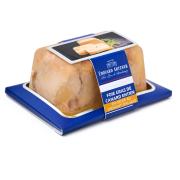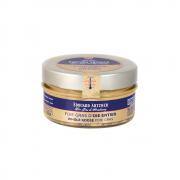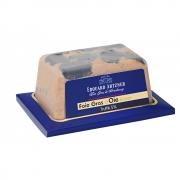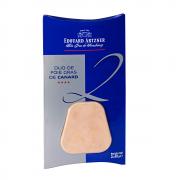
Semi-Preserved Foie Gras
Semi-preserved liver pâté is cooked at a higher temperature than fresh liver pâté, which gives it a firmer consistency. It is cooked through at 80°C and is available in a jar or in a tray.
How to Choose a Good Semi-Cooked Foie Gras: A Buying Guide with 7 Tips from the Maison
Here is our Semi-Cooked Foie Gras Guide to help you learn everything about this delicate dish! Semi-cooked Foie Gras, also known as "semi-preserved," is prepared in a terrine or wrapped in a cloth and cooked at a temperature between 70°C and 85°C. This gentle cooking process preserves its creamy texture and subtle flavors while ensuring good shelf life. It can be stored in the refrigerator for several months. It is often preferred for its more pronounced flavor and smoothness, compared to canned Foie Gras, which is cooked at higher temperatures. Not sure which semi-cooked Foie Gras to choose? Here are 7 tips to guide your purchase.
1. Foie Gras from Goose vs. Foie Gras from Duck: How to Make the Right Choice?
There are many factors to consider when making the right choice of Foie Gras. For a more general overview, you can consult our comprehensive Foie Gras guide that lists them all. Here are the differences between the specialties of our two types of waterfowl:
– Origin and seasoning: Duck is the star of Southwest France, often seasoned simply. In Alsace, goose is more prominent. The seasonings used in the East are inspired by various Christmas spices.
– Weight of a whole liver: Between 350 and 600 g for the duck, compared to a range of 400 to 700 g for the goose.
– Color: Yellow-orange for duck, and pink for its goose cousin.
– Taste: More mildness and refinement in goose, versus more robustness and intensity in duck.
– Price: Due to the more complex feeding method of the goose, its price is higher.
Ready to order? Discover our full range of semi-cooked Foie Gras! To help you make the right choice when buying online, we’ve created a specific online shopping guide just for you!
2. Differences Between Alsace and Southwest Foie Gras: Key Points to Remember
Producers in the Southwest focus on duck Foie Gras, with a faster production process than goose. The taste of duck is rustic and bold, and these artisans season it minimally: salt and pepper are enough to bring out all its flavors!
In Alsace, the tradition focuses on goose, known for being more refined. The seasoning takes center stage! Created by our Maison, the secret 11-spice recipe is a hallmark of French gastronomy. Since 1780, slow cooking in a terrine has won over many discerning palates, even at the royal court! Philippe Artzner was the first to cover the lobes in fat to extend preservation. This method, combined with terrine cooking, enhances the creaminess of the Foie Gras. Much like wine, letting your Foie Gras mature allows it to absorb the exuded fat over time, making it even better.
🥄 Semi-cooked Foie Gras from the Southwest is ideal if:
– You enjoy intense flavor experiences;
– You prefer a good quality-to-price ratio;
– You like simple seasonings with salt and pepper, or alcohol-based ones like cognac or armagnac.
🥄 Semi-cooked Foie Gras from Alsace is ideal if:
– You are looking for high-end products;
– You favor finesse over strength;
– You love Christmas-inspired flavors like gingerbread.
3. Check the Quality of Ingredients and Farming Conditions Before Buying Your Foie Gras
Several criteria are essential when assessing the superiority of a Foie Gras. Here are the main aspects to consider:
- Origin and traceability: Renowned regions like the Southwest of France and Alsace are synonymous with high quality. The ability to trace the journey of the Foie Gras from the farm to the processing plant is also a mark of transparency.
- Visual appearance: A good Foie Gras should have a uniform color, ranging from beige to pink. Spots, visible veins, or color variations may indicate flaws. Its surface should be smooth and free of imperfections.
- Weight: as mentioned earlier. Being too light may indicate a lack of richness, while an overly heavy liver could be too fatty.
- Lack of bleeding: There should be no traces of blood, as this could affect the density and taste.
- Preparation and storage: The cooking method should be clearly indicated. Each temperature level brings different nuances in terms of flavor and texture. The cold chain must be respected to ensure the freshness and premium quality of the product. Check expiration dates and storage conditions.
- Farming conditions according to the Euro Foie Gras Charter: ample, GMO-free feed, free access to drinking water, light, heating, and ventilation in living areas, constant monitoring of hygiene and health conditions, etc.
At Édouard Artzner, our commitment is reflected in the high-end products we offer and in the values that drive our team. All Foie Gras are first sorted at the slaughterhouse, then undergo a second selection by our sorting chefs. The pursuit of excellence remains consistent over time.
Just like good grapes for wine or quality shrubs for coffee, the finished product is only as good as the care taken throughout its value chain.
4. Choose Artisan Foie Gras Recipes Over Mass-Market Brands
Traditional Foie Gras houses possess unique expertise, passed down through generations of chefs. This transmission preserves ancient techniques and authentic recipes, ensuring superior quality and incomparable taste. By choosing these criteria, you are guaranteed to enjoy a Foie Gras crafted with meticulous care and attention to detail, unlike the often standardized products of mass markets.
By choosing Foie Gras houses based in Alsace, you support local businesses and the regional economy. The terroir is respected through close collaboration with local farmers and producers, ensuring environmentally friendly and animal-friendly practices and preserving original culinary traditions.
🥄 A tasty fact about the traditional truffled Foie Gras recipe: It combines the richness of Foie Gras with the unique aroma of truffle. Complemented by mushrooms, eggs, a Viognier, a Côte de Nuits from Burgundy, or a traditional champagne, it's perfect for special occasions!
5. Choose Your Format: Slices, Jar, Loaf, or Whole Foie Gras Lobes
Here is a summary of the different uses according to format:
Slices
| Occasion | Ideal for individual meals or small gatherings |
| Number of Guests | 2 to 6 people |
| Presentation | Elegant on individual plates, easy to serve |
| The Plus | Quick preparation with no need for cutting |
Jar
| Occasion | Perfect for long-term consumption and special occasions |
| Number of Guests | 6 to 12 people or more |
| Presentation | Traditional, can be unmolded and sliced in front of guests |
| The Plus | For lovers of dense texture and long shelf life |
Loaf
| Occasion | Modern and elegant presentation |
| Number of Guests | 4 to 8 people |
| Presentation | Uniform slices for a neat presentation |
| The Plus | Contemporary presentation |
Whole Lobes
| Occasion | For professional chefs or home cooks, personalized menus |
| Number of Guests | 8 to 15 people |
| Presentation | Maximum flexibility, whole cooking or in a terrine |
| The Plus | For lovers of authenticity and control over the cooking process |
🥄 Do you prefer Foie Gras with pieces? Take a few minutes to discover how to properly choose your block of Foie Gras. And if you change your mind for a gentler cooking, here is our guide to fresh Foie Gras.
6. The Best Food and Wine Pairings for Semi-Cooked Foie Gras
The pronounced creaminess of semi-cooked Foie Gras and its pure aroma allow for various wine pairings, here are some examples:
| White Wine | Gewurztraminer, Pinot Gris, Riesling, Meursault, Pouilly-Fuissé |
| Red Wine | Vosne-Romanée, Volnay, Châteauneuf-du-Pape |
| Champagne | Chardonnay Blanc de Blancs |
Excessive alcohol consumption is harmful to your health, so don't forget the water!
7. Semi-Cooked Foie Gras Guide: Our Final Criteria for Choosing Your Foie Gras
Recommended Weight per Person
As a full starter with just a few grains of salt, plan for between 60 and 80 g per person for the biggest gourmets. Less if your meal is generous: 30 or 40 g may suffice, especially if you opt for a side of bread, chutney, or confit that fills you up. For pan-fried Foie Gras, count on 100 to 120 g.
Pregnancy and Semi-Cooked Foie Gras
Semi-cooked Foie Gras is perfectly safe for pregnant women because it is cooked at over 80°C, eliminating any parasitic risks, unlike fresh Foie Gras cooked at under 75°C. As with all rich foods, moderate consumption is advised. Treat yourself with our preserves!
This semi-cooked Foie Gras guide reminds us that the most important thing is to choose based on your preferences and the circumstances of your meal. Discover even more recipe ideas in our article on the characteristics and serving suggestions for semi-cooked Foie Gras. Block on toasted bread, pan-fried for Christmas, or in whole lobes for cooking, the diversity of our products ensures that all tastes and occasions are satisfied!




